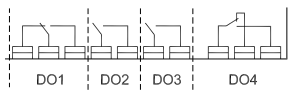Danfoss EKC 202A Taolo ea Taolo ea Mocheso
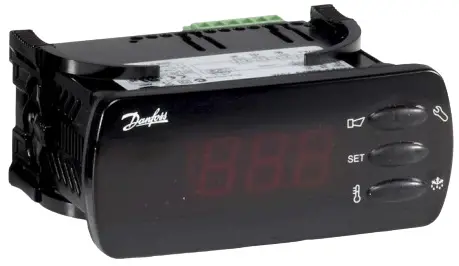
Selelekela
Kopo
- The controller is used for temperature control of refrigeration appliances and cold rooms in supermarkets
- Control of defrost, fans, alarm and light
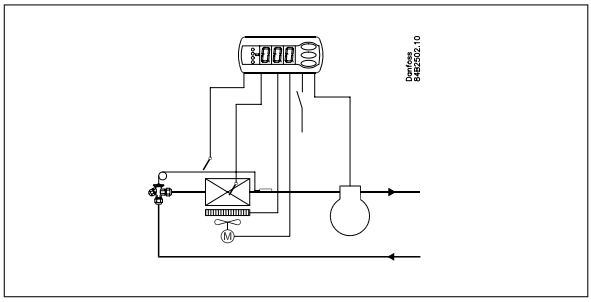
Molao-motheo
The controller contains a temperature control where the signal can be received from one temperature sensor. The sensor is placed in the cold air flow after the evaporator or in the warm air flow just before the evaporator. The controller controls the defrost with either natural defrost or electric defrost. Renewed cutting after defrost can be accomplished based on time or temperature. A measurement of the defrost temperature can be obtained directly through the use of a defrost sensor. Two to four relays will cut the required functions in and out – the application determines which:
- Refrigeration (compressor or solenoid valve)
- Kheloha
- Fane
- Alamo
- Leseli
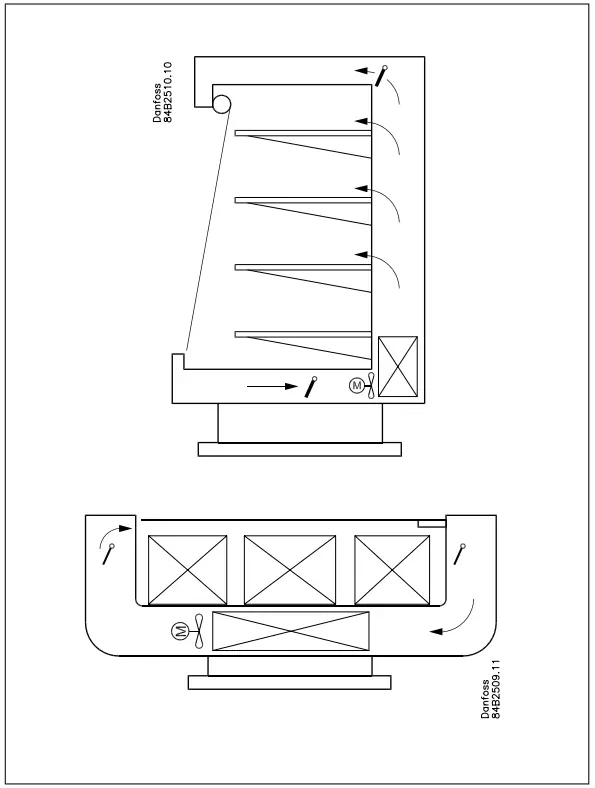
The different applications are described on the next page.
Advantages
- Integrated refrigeration-technical functions
- Defrost on demand in 1:1 systems
- Buttons and seal are embedded in the front
- IP65 enclosure on the front panel
- Digital input for either:
- Mosebetsi oa ho kopana le monyako o nang le alamo
- Defrost qala
- Ho qala/ho emisa ho laola
- Ts'ebetso ea bosiu
- Phetoho lipakeng tsa litšupiso tse peli tsa mocheso
- Mosebetsi oa ho hloekisa linyeoe
- Instant programming via programming key
- HACCP Factory calibration that will guarantee better measurement accuracy than stated in the standard EN ISO 23953-2 without subsequent calibration (Pt 1000 ohm sensor)
Module o eketsehileng
- The controller can afterwards be fitted with an insertion module if the application requires it. The controller has been prepared with plug, so the module simply has to be pushed in.
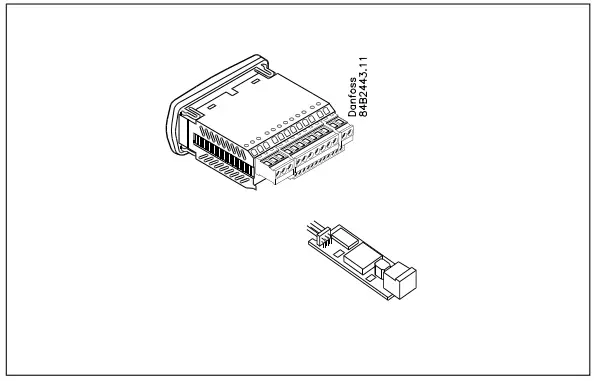
EKC 202A
Controller with two relay outputs, two temperature sensors, and a digital input. Temperature control at the start/stop of the compressor/solenoid valve
Sensor ea defrost
Electrical defrost / gas defrost
Mosebetsi oa alamo
If an alarm function is required, relay number two may be used for it. Defrost is performed here with a circulation of the air as the fans are operating continuously.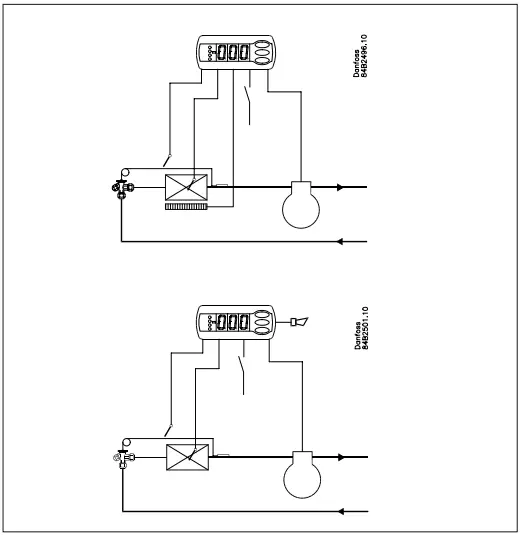
EKC 202B
Controller with three relay outputs, two temperature sensors, and a digital input. Temperature control at start/stop of compressor/solenoid valve, Defrost sensor, Electrical defrost / gas defrost Relay output 3 is used for control of fan.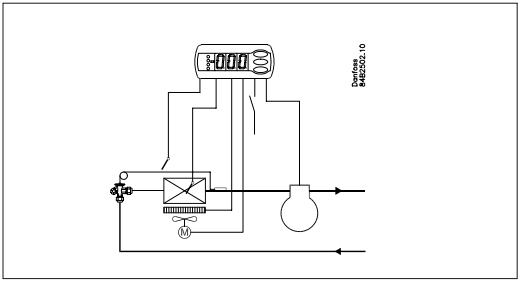
EKC 202C
Controller with four relay outputs, two temperature sensors, and a digital input. Temperature control at start/stop of compressor/solenoid valve, Defrost sens, or Electrical defrost / gas defrost. Control of fan Relay output 4 can be used for an alarm function or for a light function.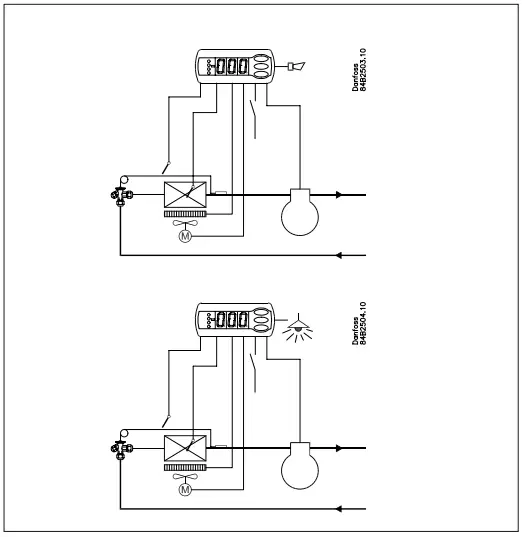
Ho qala ha defrost
Defrost e ka qalisoa ka mekhoa e fapaneng
Nakoana: Defrost is started at fixed time intervals, say, every eight hours
- Nako ea sehatsetsi: Defrost is started at fixed refrigeration time intervals. In other words, a low need for refrigeration will ”postpone” the coming defrost
- Ikopanye Defrost is started here with a pulse signal on a digital input.
- Buka An extra defrost can be activated from the controller’s lowest button
- S5-temp. In 1:1 systems, the efficiency of the evaporator can be followed. Icing up will start a defrost.
- Kemiso Defrost here can be started at fixed times of the day and night. But max. six defrosts
- Marang-rang Defrost e ka qalisoa ka puisano ea data
All the mentioned methods can be used at random – if just one of them is activated, a defrost will be started. When the defrost starts, the defrost timers are set at zero.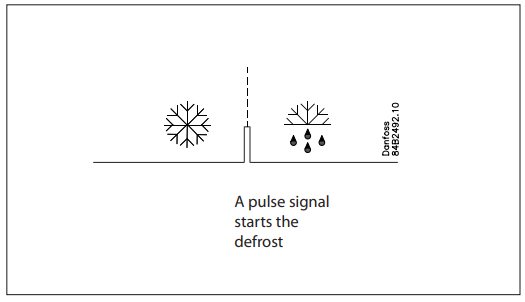
Haeba o hloka defrost e hokahaneng, sena se tlameha ho etsoa ka puisano ea data.
Kenyelletso ea dijithale
The digital input can be used for the following functions:
- Door contact function with alarm if the door has been open for too long.
- Defrost qala
- Ho qala/ho emisa ho laola
- Change-over to night operation
- Ho hloekisa nyeoe
- Change to another temperature reference
- Inject on/off
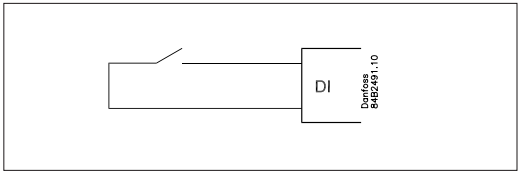
Mosebetsi oa ho hloekisa linyeoe
This function makes it easy to steer the refrigeration appliance through a cleaning phase. Via three pushes on a switch, you change from one phase to the next phase. The first push stops the refrigeration – the fans keep working.”Later”: The next push stops the fans.”Still later,”: The next push restarts refrigeration The different situations can be followed on the display. There is no temperature monitoring during case cleaning. On the network, a cleaning alarm is transmitted to the system unit. This alarm can be ”logged” so that proof of the sequence of events is provided.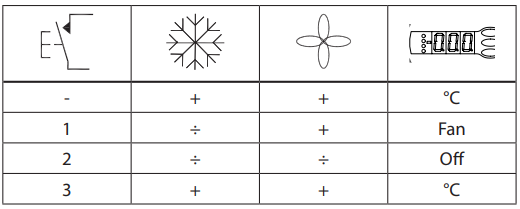
Defrost ha ho hlokahala
- Based on refrigeration time, when the aggregate refrigeration time has passed a fixed time, a defrost will be started.
- Based on temperature, the controller will constantly follow the temperature at S5. Between two defrosts, the S5 temperature will become lower the more the evaporator ices up (the compressor operates for a longer time and pulls the S5 temperature further down). When the temperature passes a set allowed variation, the defrost will be started.
This function can only be used in 1:1 systems
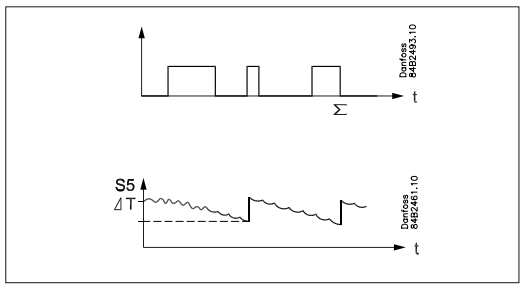
Tshebetso
Pontšo
Litekanyetso li tla bontšoa ka linomoro tse tharo, 'me ka tlhophiso u ka tseba hore na mocheso o lokela ho bontšoa ho °C kapa °F.
Light-emitting diodes (LED) karolong e ka pele
There are leds on the front panel which will light up when the belonging relay is activated.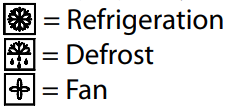
The light-emitting diodes will flash when there is an alarm. In this situation, you can download the error code to the display and cancel/sign for the alarm by giving the top button a brief push.
Kheloha
During defrost a–d– is shown in the display. This view will continue up to 15 min. after the cooling has resumed. However, the view of –d– will be discontinued if:
- Mocheso o loketse ka hare ho metsotso e 15
- The regulation is stopped with the “Main Switch”
- Ho hlaha alamo ea mocheso o phahameng
Likonopo
Ha u batla ho fetola tlhophiso, likonopo tse holimo le tse tlase li tla u fa boleng bo holimo kapa bo tlase, ho latela konopo eo u e tobang. Empa pele o fetola boleng, o tlameha ho fihlella ho menu. U fumana sena ka ho tobetsa konopo e kaholimo metsotsoana e 'maloa - ebe u kenya kholomo ka likhoutu tsa paramethara. Fumana khoutu ea parameter eo u batlang ho e fetola 'me u tobetse li-buttons tse bohareng ho fihlela boleng ba parameter bo bontšoa. Ha o fetotse boleng, boloka boleng bo bocha ka ho tobetsa konopo e bohareng hape.
Examples
Seta menu
- Tobetsa konopo e ka holimo ho fihlela paramethara r01 e bonts'oa
- Push the upper or the lower button and find the parameter you want to change
- Tobetsa konopo e bohareng ho fihlela boleng ba parameter bo bonts'oa
- Tobetsa konopo e ka holimo kapa e tlase ebe u khetha boleng bo bocha
- Push the middle button again to enter the value. Cutout alar,m relay / receipt alarm/see alarm code
- Tobetsa konopo e ka holimo hakhutšoanyane
- If there are several alarm codes, they are found in a rolling stack. Push the uppermost or lowermost button to scan the rolling stack.
Seta mocheso
- Tobetsa konopo e bohareng ho fihlela boleng ba mocheso bo bonts'oa
- Tobetsa konopo e ka holimo kapa e tlase ebe u khetha boleng bo bocha
- Push the middle button to select the setting
Manuel starts or stop the defrost
- Push the lower button for four seconds. See the temperature at the defrost sensor
- Push briefly the lower button. If no sensor has been mounted, ”non” will appear.
100% tight
The buttons and the seal are imbedded in the front. A special moulding technique unites the hard front plastic, the softer buttons and the seal, so that they become an integral part of the front panel. There are no openings that can receive moisture or dirt.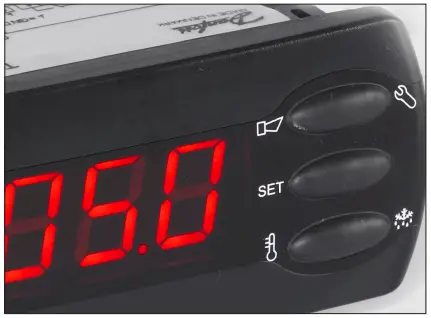
| Mekhahlelo | Molaoli | Min.- boleng | Max.- value | Feme tlhophiso | Boemo ba 'nete | |||
| Mosebetsi | Likhoutu | EKC
202A |
EKC
202B |
EKC
202C |
||||
| Ts'ebetso e tloaelehileng | ||||||||
| Mocheso (setulo se behiloeng) | — | -50°C | 50°C | 2°C | ||||
| Thermostat | ||||||||
| Phapang | r01 | 0,1 K | 20 K | 2 K | ||||
| Max. limitation of set point setting | r02 | -49°C | 50°C | 50°C | ||||
| Min. moedi wa ho beha ntlha e behiloeng | r03 | -50°C | 49°C | -50°C | ||||
| Phetoho ea pontšo ea mocheso | r04 | -20 K | 20 K | 0.0 K | ||||
| Thempereichara (°C/°F) | r05 | °C | °F | °C | ||||
| Tokiso ya letshwao le tswang ho Sair | r09 | -10 K | 10 K | 0 K | ||||
| Manual service(-1), stop regulation(0), start regulation (1) | r12 | -1 | 1 | 1 | ||||
| Ho falla ha litšupiso nakong ea ts'ebetso ea bosiu | r13 | -10 K | 10 K | 0 K | ||||
| Ts'ebetso ea phalliso ea litšupiso r40 | r39 | TLOA | on | TLOA | ||||
| Value of reference displacement (activation by r39 or DI) | r40 | -50 K | 50 K | 0 K | ||||
| Alamo | ||||||||
| Ho lieha bakeng sa alamo ea mocheso | A03 | 0 mets | 240 mets | 30 mets | ||||
| Ho lieha ha alamo ea monyako | A04 | 0 mets | 240 mets | 60 mets | ||||
| Ho lieha ha alamo ea mocheso ka mor'a ho qhibiliha | A12 | 0 mets | 240 mets | 90 mets | ||||
| Moeli o phahameng oa alamo | A13 | -50°C | 50°C | 8°C | ||||
| Moeli o tlase oa alamo | A14 | -50°C | 50°C | -30°C | ||||
| Alamo e lieha DI1 | A27 | 0 mets | 240 mets | 30 mets | ||||
| High alarm limit for condenser temperature (o70) | A37 | 0°C | 99°C | 50°C | ||||
| Sekontiri | ||||||||
| Min. Ka nako | c01 | 0 mets | 30 mets | 0 mets | ||||
| Min. NAKO-nako | c02 | 0 mets | 30 mets | 0 mets | ||||
| Compressor relay must cutin and out inversely (NC-function) | c30 | 0 / TSOELA | 1 / ka | 0 / TSOELA | ||||
| Kheloha | ||||||||
| Defrost method (none/EL/gas) | d01 | che | khase | EL | ||||
| Defrost setopong mocheso | d02 | 0°C | 25°C | 6°C | ||||
| Nako e pakeng tsa defrost e qala | d03 | Lihora tse 0 | Lihora tse 48 | Lihora tse 8 | ||||
| Max. defrost nako | d04 | 0 mets | 180 mets | 45 mets | ||||
| Ho falla ha nako ho cutin of defrost ha ho qala | d05 | 0 mets | 240 mets | 0 mets | ||||
| Nako ea ho phomola | d06 | 0 mets | 60 mets | 0 mets | ||||
| Ho lieha ha fan ho qala ka mor'a ho qhibiliha | d07 | 0 mets | 60 mets | 0 mets | ||||
| Mocheso o qalang oa fene | d08 | -15°C | 0°C | -5°C | ||||
| Fan cutin nakong ea defrost
0: E emisitse 1: Running during the whole phase 2: Running during the heating phase only |
d09 | 0 | 2 | 1 | ||||
| Defrost sensor (0=time, 1=S5, 2=Sair) | d10 | 0 | 2 | 0 | ||||
| Max. aggregate sehatsetsi nako pakeng tsa defrosts tse peli | d18 | Lihora tse 0 | Lihora tse 48 | Lihora tse 0 | ||||
| Defrost on demand – S5 temperature’s permitted variation during frost build-up. On
central plant choose 20 K (=off) |
d19 | 0 K | 20 K | 20 K | ||||
| Fans | ||||||||
| Emisa fan ho cutout compressor | F01 | che | ho joalo | che | ||||
| Ho lieha ho emisa fan | F02 | 0 mets | 30 mets | 0 mets | ||||
| Thempereichara ea ho emisa fan (S5) | F04 | -50°C | 50°C | 50°C | ||||
| Nako ea nako ea 'nete | ||||||||
| Linako tse tšeletseng tsa ho qala ho qhibiliha. Ho beha lihora.
0 = TSOANG |
t01-t06 | Lihora tse 0 | Lihora tse 23 | Lihora tse 0 | ||||
| Linako tse tšeletseng tsa ho qala ho qhibiliha. Litlhophiso tsa metsotso.
0 = TSOANG |
t11-t16 | 0 mets | 59 mets | 0 mets | ||||
| Oache - Ho beha lihora | t07 | Lihora tse 0 | Lihora tse 23 | Lihora tse 0 | ||||
| Tshupanako – Peakanyo ya motsotso | t08 | 0 mets | 59 mets | 0 mets | ||||
| Oache - Ho beha letsatsi | t45 | 1 | 31 | 1 | ||||
| Tshupanako – Tlhophiso ya kgwedi | t46 | 1 | 12 | 1 | ||||
| Oache - Ho beha selemo | t47 | 0 | 99 | 0 | ||||
| Tse fapaneng | ||||||||
| Ho lieha ha matšoao a tlhahiso ka mor'a ho tima matla | o01 | 0 s | 600 s | 5 s | ||||
| Letšoao la ho kenya ho DI1. Mosebetsi:
0=not used. 1=status on DI1. 2=door function with alarm when open. 3=door alarm when open. 4=defrost start (pulse-signal). 5=ext.main switch. 6=night operation 7=change reference (r40 will be activated) 8=alarm function when closed. 9=alarm func- tion when open. 10=case cleaning (pulse signal). 11=Inject off when open. |
o02 | 0 | 11 | 0 | ||||
| Aterese ea marang-rang | o03 | 0 | 240 | 0 | ||||
| On/Off switch (Molaetsa oa Pin ea Ts'ebeletso) | o04 | TLOA | ON | TLOA | ||||
| Khoutu ea ho kena 1 (litlhophiso tsohle) | o05 | 0 | 100 | 0 | ||||
| Mofuta oa sensor e sebelisitsoeng (Pt /PTC/NTC) | o06 | Pt | ntc | Pt | ||||
| Bontša mohato = 0.5 (e tloaelehileng 0.1 ho Pt sensor) | o15 | che | ho joalo | che | ||||
| Nako ea ho boloka nako e telele ka mor'a ho qhibiliha ho hokahaneng | o16 | 0 mets | 60 mets | 20 | ||||
| Tlhophiso ea ts'ebetso ea leseli (relay 4)
1=ON during day operation. 2=ON / OFF via data communication. 3=ON follows the DI- function, when DI is selected to door function or to door alarm |
o38 | 1 | 3 | 1 | ||||
| Ts'ebetso ea relay ea leseli (ha feela o38=2) | o39 | TLOA | ON | TLOA | ||||
| Ho hloekisa nyeoe. 0=ha ho na ho hloekisoa ha mekotla. 1=Barati feela. 2=Lipoelo tsohle Li tima. | o46 | 0 | 2 | 0 | ||||
| Khoutu ea ho kena 2 (karolelano ea phihlello) | o64 | 0 | 100 | 0 | ||||
| Save the controllers present settings to the programming key. Select your own number. | o65 | 0 | 25 | 0 | ||||
| Load a set of settings from the programming key (previously saved via o65 function) | o66 | 0 | 25 | 0 | ||||
| Fetola li-setting tsa feme ea balaoli ka li-setting tsa hona joale | o67 | TLOA | On | TLOA | ||||
| Re alternative application for the S5 sensor (maintain the setting at 0 if it is used as defrost sensor, otherwise 1 = product sensor and 2 = condenser sensor with alarm) | o70 | 0 | 2 | 0 | ||||
| Select application for relay 4: 1=defrost/light, 2= alarm | o72 | defrost /
Alamo |
Leseli
Alamo |
1 | 2 | 2 | ||
| Tshebeletso | ||||||||
| Mocheso o lekantsoe ka sensor ea S5 | u09 | |||||||
| Boemo ba ho kenya DI1. ka/1=kwetswe | u10 | |||||||
| Boemo ba ts'ebetso ea bosiu (ho buloa kapa ho tima) 1=e koetsoe | u13 | |||||||
| Bala tšupiso ea hajoale ea melaoana | u28 | |||||||
| Status on relay for cooling (Can be controlled manually, but only when r12=-1) | u58 | |||||||
| Status on relay for fans (Can be controlled manually, but only when r12=-1) | u59 | |||||||
| Status on relay for defrost. (Can be controlled manually, but only when r12=-1) | u60 | |||||||
| Mocheso o lekantsoe ka sensara sa Sair | u69 | |||||||
| Status on relay 4 (alarm, defrost, light). (Can be controlled manually, but only when
r12=-1) |
u71 | |||||||
Boemo ba feme
Haeba o hloka ho khutlela ho boleng ba feme-set, e ka etsoa ka tsela ena:
- Khaola matla a phepelotage ho molaoli
- Keep the upper and lower buttons depressed at the same time as you reconnect the supply voltage.
| Phoso khoutu pontsho | Pontšo ea khoutu ea alamo | Boemo khoutu pontsho | |||
| E1 | Phoso ho molaoli | A 1 | Alamo ea mocheso o phahameng | S0 | Ho laola |
| E6 | Fetola betri + ho hlahloba oache | A 2 | Alamo ea mocheso o tlase | S1 | E emetse pheletso ea ho qhibiliha ho hokahaneng |
| E 27 | Phoso ea sensor ea S5 | A 4 | Alamo ea monyako | S2 | Compressor ea nako ea nako |
| E 29 | Phoso ea sensor ea Sair | A 5 | Max. Tšoara nako | S3 | Compressor ea nako e sa sebetseng |
| A 15 | DI 1 alarm | S4 | Nako ea ho phomola | ||
| A 45 | Boemo ba standby | S10 | Sehatsetsi se emisitsoe ke main switch | ||
| A 59 | Ho hloekisa nyeoe | S11 | Refrigeration stopped by a thermostat | ||
| A 61 | Alamo ea Condenser | S14 | Defrost tatelano. Defrosting | ||
| S15 | Defrost sequence. Fan delay | ||||
| S16 | Refrigeration stopped because of open DI
kenya letsoho |
||||
| S17 | Lemati le bulehile (ho bula DI kenyo) | ||||
| S20 | Pholiso ea tšohanyetso | ||||
| S25 | Taolo ea liphetho ka letsoho | ||||
| S29 | Ho hloekisa nyeoe | ||||
| S32 | Ho lieha ha tlhahiso ha e qala | ||||
| eseng | The defrost temperature cannot be dis-
bapala. Ho na le ho emisa ho ipapisitse le nako |
||||
| -d- | Ho tsieleha ho ntse ho tsoela pele / Ho tsidifala ha pele ka mora
senya |
||||
| PS | Password e hlokahalang. Beha phasewete | ||||
E qalang:
Taolo e qala ha voltage ho.
- Etsa tlhahlobo ea litlhophiso tsa feme. Etsa liphetoho tse hlokahalang ho li-parameter tse fapaneng.
- For the network. Set the address in o03 and then transmit it to the gateway/ system unit with setting o04.
Mesebetsi
Here is a description of the individual functions. A controller only contains this part of the functions. Cf. the menu survey.
| Mosebetsi | Paramethara | Parameter by operation via data com- munication |
| Tloaelehileng pontsho | ||
| Normally the temperature value from thermostat sensor Sair is displayed. | Bontša moea (u69) | |
| Thermostat | Taolo ea thermostat | |
| Beha ntlha
Melao e ipapisitse le boleng bo behiloeng hammoho le phalliso, haeba ho hlokahala. Theko e behiloe ka ho tobetsa konopo e bohareng. Theko e behiloeng e ka notleloa kapa ea lekanyetsoa ho mefuta e fapaneng ka li-setting tsa r02 le r03. The reference at any time can be seen in ”u28 Temp. ref” |
Sekoahelo °C | |
| Phapang
Ha mocheso o phahame ho feta referense + phapang e behiloeng, relay ea compressor e tla khaoloa. E tla khaola hape ha mocheso o theoha ho ea ho referense e behiloeng. |
r01 | Phapang |
| Beha ntlha moedi
The controller’s setting range for the set point may be narrowed down, so that much too high or much too low values are not set accidentally – with resulting damages. |
||
| To avoid a too high setting of the set point, the max. allowable reference value must be lowered. | r02 | Sekoahelo se phahameng °C |
| To avoid a too low setting of the set point, the min. allowable reference value must be increased. | r03 | Mokotla o fokolang °C |
| Ho lokisoa ha mocheso oa ponts'o
Haeba mocheso lihlahisoa le mocheso o amoheloang ke molaoli li sa tšoane, ho ka etsoa phetoho ea offset ea mocheso o bontšitsoeng. |
r04 | Disp. Adj. K |
| Mocheso oa mocheso
Beha mona haeba molaoli e le ho bonts'a maemo a mocheso ho °C kapa ho °F. |
r05 | Temp. unit
°C=0. / °F=1 (Ke °C feela ho AKM, ho sa tsotellehe hore na boemo ke bofe) |
| Khalemelo of sesupo from Sair
Monyetla oa matšeliso ka cable e telele ea sensor |
r09 | Fetola Sair |
| Ho qala/ ho emisa sehatsetsing
Ka tlhophiso ena sehatsetsi se ka qalisoa, sa emisoa kapa ho fetella ka letsoho ho ka lumelloa. Start / stop of refrigeration can also be accomplished with the external switch function con- nected to the DI input. Sehatsetsi se emisitsoeng se tla fana ka "alamo e emeng". |
r12 | Main switjha
1: Qala 0: Emisa -1: Taolo ea liphetho e lumelletsoeng ka letsoho |
| Theko ea ho khutlisa bosiu
The thermostat’s reference will be the set point plus this value when the controller changes over to night operation. (Select a negative value if there is to be cold accumulation.) |
r13 | Qetello ea bosiu |
| Ts'ebetso ea phetisetso ea litšupiso
When the function is changed to ON the thermostat differential will be increased by the value in r40. Activation can also take place via input DI (defined in o02).
|
r39 | Th. offset |
| Boleng ba ho falla ha litšupiso
The thermostat reference and the alarm values are shifted by the following number of degrees when the displacement is activated. Activation can take place via r39 or input DI |
r40 | Th. ho tloha K |
| Bosiu bosiu
(start of night signal) |
| Alamo | Litlhophiso tsa alamo | |
| Molaoli a ka fana ka alamo maemong a fapaneng. Ha ho na le alamo, li-light-emitting diode (LED) li tla benya holim'a karolo e ka pele ea controller, 'me alamo e tla tima. | With data communication, the importance of individual alarms can be defined. Setting is carried out in the “Alarm destinations” menu. | |
| Alamo e lieha (alamo e lieha)
If one of the two limit values is exceeded, a timer function will commence. The alarm will not become active until the set time delay has passed. The time delay is set in minutes. |
A03 | Alamo e lieha |
| Ho lieha ha nako bakeng sa alamo ea monyako
Nako ea ho lieha e behiloe ka metsotso. Mosebetsi o hlalosoa ho o02. |
A04 | DoorOpen del |
| Ho lieha ha nako bakeng sa ho pholisa (alamo e lieha nako e telele)
This time delay is used during start-up, during defrost, and immediately after a defrost. There will be change-over to the normal time delay (A03) when the temperature has dropped below the set upper alarm limit. Nako ea ho lieha e behiloe ka metsotso. |
A12 | Hlakola del |
| Moeli o kaholimo oa alamo
Here you set when the alarm for high temperature is to start. The limit value is set in °C (absolute value). The limit value will be raised during night operation. The value is the same as the one set for night setback, but will only be raised if the value is positive. Boleng ba moeli bo tla phahamisoa hape mabapi le phalliso ea litšupiso r39. |
A13 | HighLim Air |
| Moeli o tlase oa alamo
Mona u beha hore na alamo ea mocheso o tlase e tla qala neng. Boleng ba moeli bo behiloe ho °C (boleng bo felletseng). Boleng ba moeli bo tla phahamisoa hape mabapi le phalliso ea litšupiso r39. |
A14 | Moea oa LowLim |
| Delay of a DI alarm
A cut-out/cut-in input will result in alarm when the time delay is passed. The function is defined in o02. |
A27 | AI.Delay DI |
| High alarm limit for condenser temperature
If the S5 sensor is used for monitoring the condenser’s temperature you must set the value at which the alarm is to become activated. The value is set in °C. The definition of S5 as a condenser sensor is accomplished in o70. The alarm is reset again to 10 K below the set temperature. |
A37 | Condtemp Al. |
| Seta alamo bocha |
| Sekontiri | Taolo ea konpresser | |
| Relay ea compressor e sebetsa hammoho le thermostat. Ha thermostat e hloka sehatsetsi se tla sebetsa relay ea compressor. | ||
| Linako tsa ho matha
To prevent irregular operation, values can be set for the time the compressor is to run once it has been started. And for how long it at least to be stopped? Linako tsa ho sebetsa ha li hlokomeloe ha defrosts e qala. |
||
| Min. NAKONG (ka metsotso e seng mekae) | c01 | Min. Ka nako |
| Min. Nako ea ho se sebetse (ka metsotso e seng mekae) | c02 | Min. Nako ea nako |
| Reversed relay function for the compressor relay
0: Ts'ebetso e tloaelehileng moo relay e kenellang ha sehatsetsi se batloa 1: Reversed function where the relay cuts out when refrigeration is demanded (this wiring pro- duces sephetho sa hore ho tla ba le sehatsetsi haeba phepelo voltage ho molaoli e hloleha). |
c30 | Cmp e fetisetsa NC |
| Kheloha | Taolo ea serame | |
| Selaoli se na le ts'ebetso ea timer e leng zeroset ka mor'a qalo e 'ngoe le e' ngoe ea defrost. Ts'ebetso ea nako e tla qala defrost haeba / ha nako ea nako e feta.
Mosebetsi oa nako o qala ha voltage is connected to the controller, but it is displaced the first time by the setting in d05. If there is power failure, the timer value will be saved and continue from here when the power returns. Ts'ebetso ena ea timer e ka sebelisoa e le mokhoa o bonolo oa ho qala li-defrosts, empa e tla lula e sebetsa joalo ka ts'ireletso ea ts'ireletso haeba e 'ngoe ea li-defrost tse latelang e sa amoheloe. The controller also contains a real-time clock. By means of the settings of this clock and times for the required defrost times, defrost can be started at fixed times of the day. If there is a risk of power failure for periods longer than four hours, a battery module should be mounted in the controller. Defrost start can also be accomplished via data communication, via contact signals or manually e QALANG. |
||
| Mekhoa eohle ea ho qala e tla sebetsa ho molaoli. Mesebetsi e fapaneng e tlameha ho hlophisoa, e le hore li-defrosts li se ke tsa "tloha" ka mor'a tse ling.
Defrost can be accomplished with electricity, hot gas or brine. The defrost ea sebele e tla emisoa ho latela nako kapa mocheso ka lets'oao le tsoang ho sensor ea mocheso. |
||
| Mokgwa wa ho qhibidiha
Here you set whether defrost is to be accomplished with electricity or “non”. During defrost the defrost relay will be cut in. When gas defrosting the compressor relay will be cut in during defrost. |
d01 | Def. method |
| Defrost setopong mocheso
The defrost e emisoa ka mocheso o fanoeng o lekantsoeng ka sensor (sensor e hlalosoa ka d10). Theko ea mocheso e behiloe. |
d02 | Def. Emisa Mocheso |
| Nako e pakeng tsa defrost e qala
Ts'ebetso ke zeroset mme e tla qala ts'ebetso ea nako qalong ea defrost ka 'ngoe. Ha nako e felile, ts'ebetso e tla qala defrost. Ts'ebetso e sebelisoa e le qalo e bonolo ea defrost, kapa e ka sebelisoa e le tšireletso haeba lets'oao le tloaelehileng le sa hlahelle. Haeba master/slave defrost ntle le ts'ebetso ea oache kapa ntle le puisano ea data e sebelisoa, nako ea nako e tla sebelisoa joalo ka max. nako pakeng tsa defrosts. Haeba defrost e qala ka puisano ea data e sa etsahale, nako ea nako e tla sebelisoa joalo ka boholo. nako pakeng tsa defrosts. Ha ho e-na le defrost e nang le ts'ebetso ea oache kapa puisano ea data, nako ea nako e tlameha ho behoa nako e telele ho feta e reriloeng, kaha nako ea nako e tla qala defrost eo hamorao e tla lateloa ke e reriloeng. In connection with a power failure, the interval time will be maintained, and when the power returns the interval time will continue from the maintained value. Nako ea nakoana ha e sebetse ha e setetsoe ho 0. |
d03 | Sekhahla sa Def (0=theoha) |
| Nako e phahameng ea defrost
Setting ena ke nako ea ts'ireletso e le hore defrost e emisoe haeba ho so be le sebaka sa ho emisa ho ipapisitse le thempereichara kapa ka mokhoa o kopantsoeng oa defrost. (The setting will be the defrost time if d10 is selected to be 0) |
d04 | Max Def. nako |
| Nako stagho qhoma bakeng sa ho fokotsa sehatsetsi nakong ea ho qala
Ts'ebetso e sebetsa feela haeba u na le lisebelisoa tse 'maloa tsa sehatsetsi kapa lihlopha moo u batlang hore defrost e be s.tage amanang le emong. Tshebetso e boetse e sebetsa feela haeba o kgethile defrost le interval start (d03). Ts'ebetso e liehisa nako ea nako d03 ka palo e behiloeng ea metsotso, empa e e etsa hanngoe feela, 'me sena ka lekhetlo la pele la defrost e etsahalang ha vol.tage e hokahane le molaoli. Mosebetsi o tla sebetsa ka mor'a hore motlakase o mong le o mong o hlōlehe. |
d05 | Nako Stagg. |
| Nako ea ho phomola
Mona u beha nako ea ho feta ho tloha ho defrost le ho fihlela compressor e qala hape. (Nako ea ha metsi a rotha mouoane). |
d06 | Nako ea ho hula |
| Ho lieha ha fan ho qala ka mor'a ho qhibiliha
Mona u beha nako ea ho feta ho tloha ha compressor e qala ka mor'a defrost le ho fihlela fan e ka qala hape. (Nako eo metsi a "tlamelletsoeng" ho mouoane). |
d07 | FanStartDel |
| Mocheso o qalang oa fene
Fan e ka boela ea qalisoa nakoana pele ho moo ho boletsoeng tlas'a "Ho lieha ha fan ho qala ka mor'a ho senyeha", haeba sensor ea defrost S5 e ngolisa boleng bo tlaase ho feta bo behiloeng mona. |
d08 | FanStartTemp |
| Fene e khaotsoe nakong ea ho qhibiliha
Mona o ka beha hore na fan e tla sebetsa nakong ea defrost. 0: E emisitsoe (E matha nakong ea pompo e theoha) 1: Running during the whole phase 2: Running during the heating phase only. After that stopped |
d09 | FanDuringDef |
| Sensor ea defrost
Mona o hlalosa sensor ea defrost. 0: Ha ho letho, defrost e ipapisitse le nako 1: S5 2: Bonang |
d10 | DefStopSens. |
| Defrost ha ho hlokahala - nako e kopaneng ea sehatsetsing
Beha mona ke nako ea sehatsetsi e lumelletsoeng ntle le li-defrosts. Haeba nako e feta, defrost e tla qala. Ka ho beha = 0 ts'ebetso e khaotsoe. |
d18 | MaxTherRunT |
| Defrost ha ho hlokahala - mocheso oa S5
The controller will follow the effectivity of the evaporator, and via internal calculations and measurements of the S5 temperature it will be able to start a defrost when the variation of the S5 temperature becomes larger than required. Mona u beha hore na slide e kholo ea mocheso oa S5 e ka lumelloa hakae. Ha boleng bo fetisitsoe, defrost e tla qala. Ts'ebetso e ka sebelisoa feela lits'ebetsong tsa 1: 1 ha mocheso oa mouoane o tla theoha ho netefatsa hore mocheso oa moea o tla bolokoa. Litsamaiso tse bohareng mosebetsi o tlameha ho khaoloa. Ka ho beha = 20 ts'ebetso e khaotsoe |
d19 | CucutS5Dif. |
| Haeba u lakatsa ho bona mocheso ho sensor ea S5, tobetsa konopo e tlase ea molaoli. | Mocheso oa defrost. | |
| Haeba u lakatsa ho qala defrost e eketsehileng, tobetsa konopo ea "controller" e ka tlase ho metsotsoana e mene. U ka emisa defrost e tsoelang pele ka tsela e ts'oanang | Def Qala
Here you can start a manual defrost. |
|
| Tšoara Ka mor'a Def
E bonts'a HO BONAHALA ha molaoli a sebetsa ka coordinated defrost. |
||
| Defrost State Status on defrost
1= pompa fatshe / defrost |
||
| Fane | Taolo ea fan | |
| Fene e ile ea emisa ka har'a komporo e khaotsoeng
Mona o ka khetha hore na fan e tla emisoa ha compressor e khaoloa |
F01 | Fan stop CO
(Ee = Fane e emisitse) |
| Delay of fan stop when the compressor is cut out
Haeba u khethile ho emisa fan ha compressor e khaotsoe, u ka lieha ho emisa fan ha komporo e emisa. Mona o ka beha tieho ea nako. |
F02 | Fane del. CO |
| Mocheso oa ho emisa fan
The function stops the fans in an error situation, so that they will not provide power to the appli- ance. If the defrost sensor registers a higher temperature than the one set here, the fans will be stopped. There will be re-start at 2 K below the setting. Ts'ebetso ha e sebetse nakong ea defrost kapa ho qala ka mor'a defrost. Ka ho beha +50 ° C ts'ebetso e sitisoa. |
F04 | FanStopTemp |
| Ka hare defrosting kemiso / oache tshebetso | ||
| (Ha e sebelisoe haeba kemiso ea ka ntle ea defrosting e sebelisoa ka puisano ea data.) Ho ka behoa linako tse tšeletseng tsa motho ka mong bakeng sa ho qala ha defrost letsatsi lohle. | ||
| Ho qala ha defrost, ho hlophisa hora | t01-t06 | |
| Ho qala ha defrost, ho beha motsotso (1 le 11 li kopane, joalo-joalo) Ha tsohle t01 ho isa ho t16 li lekana le 0, oache e ke ke ea qala ho qhibiliha. | t11-t16 | |
| Oache ea nako ea sebele
Ho beha oache ho hlokahala feela ha ho se na puisano ea data. Haeba ho na le ho hlōleha ha matla ka nako e ka tlase ho lihora tse 'nè, mosebetsi oa oache o tla bolokeha. Ha o kenya module oa betri, ts'ebetso ea oache e ka boloka nako e telele. (EKC 202 only) |
||
| Oache: Litlhophiso tsa hora | t07 | |
| Oache: Setting ea metsotso | t08 | |
| Oache: Ho beha letsatsi | t45 | |
| Oache: Litlhophiso tsa khoeli | t46 | |
| Oache: Boemo ba selemo | t47 |
| Tse fapaneng | Tse fapaneng | |
| Ho lieha ha lets'oao la tlhahiso kamora ho qala
After start-up or a power failure, the controller’s functions can be delayed so that overloading of the electricity supply network is avoided. Mona o ka beha tieho ea nako. |
o01 | DelayOfOutp. |
| Letšoao la ho kenya la dijithale - DI
The controller has a digital input which can be used for one of the following functions: Off: The input is not used 1) Pontšo ea boemo ba mosebetsi oa ho ikopanya 2) Door function. When the input is open it signals that the door is open. The refrigeration and the fans are stopped. When the time setting in “A04” is passed, an alarm will be given and refrigeration will be resumed. 3) Door alarm. When the input is open it signals that the door is open. When the time setting in “A04” is passed, there will be alarm. 4) Defrost. The function is started with a pulse signal. The controller will register when the DI input is activated. The controller will then start a defrost cycle. If the signal is to be received by several controllers it is important that ALL connections are mounted the same way (DI to DI and GND to GND). 5) Main switch. Regulation is carried out when the input is short-circuited, and regulation is stopped when the input is put in place. OFF. 6) Night operation. When the input is short-circuited, there will be a regulation for night operation. 7) Reference displacement ha DI1 e le khutšoanyane-circuited. Ho falla ka "r40". 8) Separate alarm function. An alarm will be given when the input is short-circuited. 9) Separate alarm function. An alarm will be given when the input is opened. (For 8 and 9 the time delay is set in A27) 10) Ho hloekisa nyeoe. Ts'ebetso e qala ka lets'oao la pulse. Cf. le tlhaloso leqepheng la 4. 11) Enta ho / tima. E tima ha DI e butse. |
o02 | DI 1 Config.
Tlhaloso e etsahala ka boleng ba linomoro bo bontšitsoeng ka ho le letšehali. (0 = theoha)
DI state (Tekanyo) Boemo ba hajoale ba DI bo bontšoa mona. ON kapa TIMA. |
| Aterese
Haeba molaoli a hahiloe ka marang-rang a nang le puisano ea data, e tlameha ho ba le aterese, 'me monyako o moholo oa puisano ea data o tlameha ho tseba aterese ena. The installation of the data communication cable has been mentioned in a separate document, “RC8AC”. Aterese e behiloe lipakeng tsa 1 le 240, heke e lekantsoe The address is sent to the system manager when the menu o04 is set to ‘ON’, or when the system manager’s scanning function is activated. (o04 is only to be used if the data communication is LON.) |
After installation of data communication, the controller can be operated on an equal footing with the other controllers in ADAP- KOOL® refrigeration controls. | |
| o03 | ||
| o04 | ||
| Khoutu ea ho kena 1 (Ho fihlella litlhophiso tsohle)
If the settings in the controller are to be protected with an access code you can set a numerical value between 0 and 100. If not, you can cancel the function with setting 0. (99 will always give you access). |
o05 | – |
| Mofuta oa sensor
Normally, a Pt 1000 sensor with great signal accuracy is used. But you can also use a sensor with another signal accuracy. That may either be a PTC 1000 sensor or an NTC sensor (5000 Ohm at 25°C). Li-sensor tsohle tse kentsoeng li tlameha ho ba tsa mofuta o le mong. |
o06 | SensorConfig Pt = 0
PTC = 1 NTC = 2 |
| Bontša mohato
Yes: Gives steps of 0.5° No: Gives steps of 0.1° |
o15 | Disp. Mohato = 0.5 |
| Max. nako ea ho ema ka mor'a coordinated defrost
When a controller has completed a defrost, it will wait for a signal that tells the refrigeration may be resumed. If this signal fails to appear for one reason or another, the controller will itself starts the refrigeration when this standby time has elapsed. |
o16 | Max HoldTime |
| Tlhophiso ea ts'ebetso ea leseli
1) The relay cuts in during day operation 2) The relay to be controlled via data communication 3) The relay to be controlled by the door switch defined in either o02 where the setting is selected to either 2 or 3. When the door is opened the relay will cut in. When the door is closed again there will be a time delay of two minutes before the light is switched off. |
o38 | Leseli config |
| Tshebetso of light relay
The light relay can be activated here (if 038=2) |
o39 | Remoutu e khanyang |
| Ho hloekisa nyeoe
Boemo ba ts'ebetso bo ka lateloa mona kapa ts'ebetso e ka qalisoa ka letsoho. 0 = Normal operation (no cleaning) 1 = Cleaning with fans operating. All other outputs are Off. 2 = Cleaning with stopped fans. All outputs are Off. Haeba ts'ebetso e laoloa ke lets'oao ho DI input, boemo bo loketseng bo ka bonoa mona ho menu. |
o46 | Nyeoe e hloekile |
| Khoutu ea phihlello 2 (Fihlello ho litokiso)
There is access to adjustments of values, but not to configuration settings. If the settings in the controller are to be protected with an access code you can set a numerical value between 0 and 100. If not, you can cancel the function with setting 0. If the function is used, access code 1 (o05) e tlameha hape sebedisoa. |
o64 | – |
| Kopitsa litlhophiso tsa hona joale tsa molaoli
With this function, the controller’s settings can be transferred to a programming key. The key can contain up to 25 different sets. Select a number. All settings except for Address (o03) will be copied. When copying has started, the display returns to o65. After two seconds, you can move into the menu again and check whether the copying was satisfactory. Showing of a negative figure spells problems. See the significance in the Fault Message section. |
o65 | – |
| Kopitsa ho tsoa ho konopo ea lenaneo
This function downloads a set of settings previously saved in the controller. Select the relevant number. All settings except for Address (o03) will be copied. When copying has started the display returns to o66. After two seconds, you can move back into the menu again and check whether the copying was satisfactory. Showing of a negative figure spells problems. See the significance in the Fault Message section. |
o66 | – |
| Boloka joalo ka tlhophiso ea feme
With this setting you save the controller’s actual settings as a new basic setting (the earlier fac- tory settings are overwritten). |
o67 | – |
| Other application for S5 sensor
Maintain the setting at 0 if the sensor has been defined as defrost sensor in D10. If D10 has been set at 0 or 2 the S5 input can be used as product sensor or condenser sensor. Here you define which: 0: Defrost sensor 1: Product sensor 2: Condenser sensor with alarm |
o70 | S5 Config |
| Phetiso 4
Here you define the application for relay 4: 1: Defrost (EKC 202A) or Light (EKC 202C) 2: Alarm |
o72 | DO4 Config |
| – – – Ho kgutlela morao bosiu 0=Letsatsi
1=Bosiu |
| Tshebeletso | Tshebeletso | |
| Mocheso o lekantsoe ka sensor ea S5 | u09 | Mocheso oa S5. |
| Status on DI input. on/1=closed | u10 | Boemo ba DI1 |
| Status on night operation (on or off) 1=night operation | u13 | Night Cond. |
| Bala tšupiso ea hajoale ea melaoana | u28 | Temp. ref. |
| * Status on relay for cooling | u58 | Comp1/LLSV |
| * Status on relay for fan | u59 | Phetiso ea fan |
| * Status on relay for defrost | u60 | Def. phetiso |
| * Temperature measured with Sair sensor | u69 | Sair temp |
| * Status on relay 4 (alarm, defrost or light function) | u71 | DO4 status |
| *) Ha se lintho tsohle tse tla bontšoa. Ho ka bonoa feela tšebetso ea sesebelisoa se khethiloeng. |
| Molaetsa wa phoso | Dialamo | |
| In an error situation the LED’s on the front will flash and the alarm relay will be activated. If you push the top button in this situation you can see the alarm report in the display. If there are further push again to see them.
There are two kinds of error reports – it can either be an alarm occurring during the daily opera- tion, or there may be a defect in the installation. Li-alamo li ke ke tsa bonahala ho fihlela tieho ea nako e behiloeng e felile. Ka lehlakoreng le leng, lialamo tsa elektronike li tla bonahala hang ha phoso e etsahala. (Alamo e ke ke ea bonahala ha feela ho na le alamo ea E e sebetsang). Melaetsa e ka hlahang ke ena: |
1 = alamo |
|
| A1: Alamo ea mocheso o phahameng | Phahameng t. alamo | |
| A2: Alamo e tlase ea mocheso | Tlase t. alamo | |
| A4: Alamo ea monyako | Alamo ea Monyako | |
| A5: Boitsebiso. Paramethara o16 e feletsoe ke nako | Max Hold Nako | |
| A15: Alamo. Letšoao le tsoang ho DI | Alamo ea DI1 | |
| A45: Boemo ba standby (sehatsetsi se emisitsoeng ka r12 kapa DI input) | Boemo ba standby | |
| A59: Ho hloekisa linyeoe. Letšoao le tsoang ho DI | Ho hloekisa nyeoe | |
| A61: Alamo ea condenser | Cond. alarm | |
| E1: Liphoso ho molaoli | EKC phoso | |
| E6: Phoso ka oache ea nako ea nnete. Sheba betri / seta oache bocha. | – | |
| E27: Phoso ea kutlo ho S5 | Phoso ea S5 | |
| E29: Phoso ea sensor ho Sair | Phoso ea Sair | |
| When copying settings to or from a copying key with functions o65 or o66, the following infor- mation may appear:
0: Ho kopitsa ho phethiloe 'me ho lokile 4: Senotlolo sa ho kopitsa ha sea kenngoa ka nepo 5: Ho kopitsa ho ne ho sa nepahala. Pheta ho kopitsa 6: Ho kopitsa ho EKC ho fosahetse. Pheta ho kopitsa 7: Ho kopitsa konopo ea ho kopitsa ho fosahetse. Pheta ho kopitsa 8: Ho kopitsa ha ho khonehe. Nomoro ea odara kapa mofuta oa SW ha o tsamaellane le 9: Phoso ea puisano le nako e felile 10: Ho kopitsa ho ntse ho tsoela pele (The information can be found in o65 or o66 a couple of seconds after copying has been started). |
||
| Libaka tse llang | ||
| Bohlokoa ba lialamo ka bomong bo ka hlalosoa ka maemo (0, 1, 2 kapa 3) |
Tlhokomediso! Direct start of compressors
To prevent compressor breakdown parameters c01 and c02 should be set according to the supplier’s requirements o,r in general, Hermetic Compressors c02 min. 5 minutes, Semihermetic Compressors c02 min. 8 minutes, and c01 min. 2 to 5 minutes ( Motor from 5 to 15 KW ) * ). Direct activation of solenoid valves does not require settings different from factory (0).
Fetola
Selaoli se na le mesebetsi e mengata e ka sebelisoang hammoho le ts'ebetso ea override ho master gateway / Motsamaisi oa Sisteme.
|
Mosebetsi ka puisano ea data |
Mesebetsi e lokelang ho sebelisoa ka har'a li-gateway's ts'ebetso ea ho fetisa |
E sebelisitsoe parameter ho EKC 202 |
| Qaleho ea ho defrosting | Taolo ea defrost Kemiso ea nako | – – – Def. qala |
| Sehatsetsi se kopaneng | Taolo ea serame |
– – – HoldAfterDef u60 Def.relay |
| Bosiu bosiu |
Taolo ya motsheare/bosiu Kemiso ya nako |
– – – Bosiu setbck |
| Taolo ea khanya | Taolo ya motsheare/bosiu Kemiso ya nako | o39 Khanya Remoutu |
Lihokelo
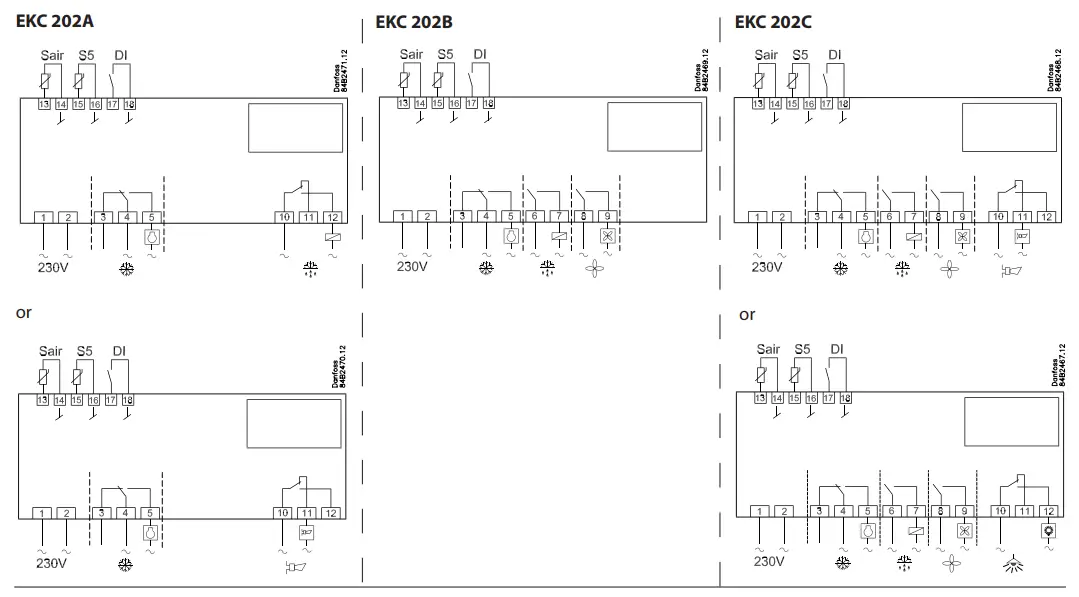
Phepelo ea motlakase
- 230 V ac
Li-sensor
- Sair is a thermostat sensor.
- S5 is a defrost sensor and is used if defrost has to be stopped based on temperature. It may, however, also be used as a product sensor or condenser sensor.
Digital On/Off signal
A cut-in input will activate a function. The possible functions are described in menu o02.
Li-relay
The general connections are: Refrigeration. The contact will cut in when the controller demands refrigeration Defrost. Fan.
- Alarm. The relay is cut out during normal operation and cuts in in alarm situations and when the controller is dead (de-energised)
- Light. The contact will cut in when the controller demands light.
Lerata la motlakase
Cables for sensors, DI inputs, and data communication must be kept separate from other electrical cables:
- Sebelisa literei tsa cable tse arohaneng
- Boloka sebaka se pakeng tsa likhoele bonyane 10 cm
- Lithapo tse telele tse kenyang DI li lokela ho qojoa
Puisano ya data
If data communication is used, it is important that the installation of the data communication cable is performed correctly. See the separate literature No. RC8AC.
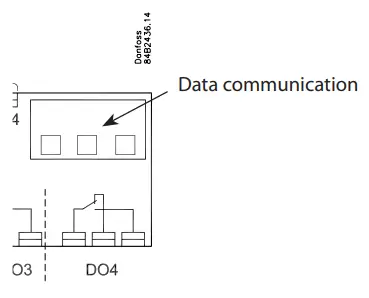
- MODBUS kapa LON-RS485 ka ho kenya likarete.
Ho laela
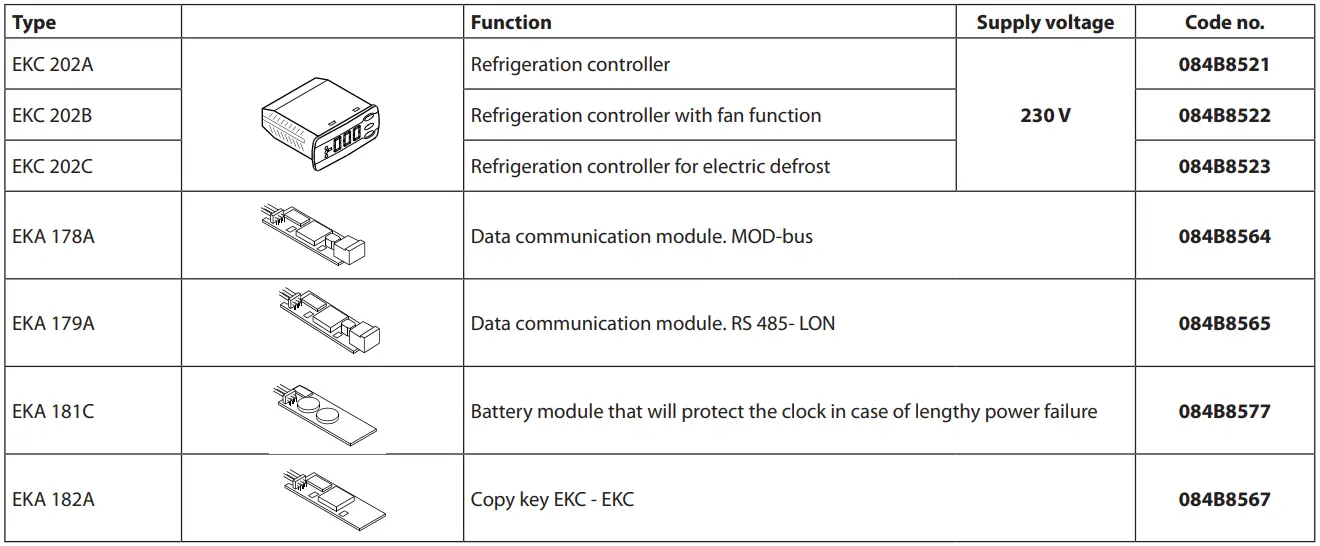
- Li-sensor tsa mocheso: please refer to lit. no. RK0YG

Lintlha tsa tekheniki
| Phepelo voltage | 230 V ac +10/-15%. 2.5 VA, 50/60 Hz | ||
| Li-sensors tse 3 li theotsoe | Pt 1000 kapa
PTC 1000 kapa NTC-M2020 (5000 ohm / 25°C) |
||
|
Ho nepahala |
Lekhalo la ho lekanya | -60 ho ea ho +99°C | |
|
Molaoli |
±1 K ka tlase ho -35°C
±0.5 K pakeng tsa -35 ho +25°C ±1 K ka holimo ho +25°C |
||
| Pt 1000
kutlo |
±0.3 K ho 0°C
± 0.005 K ka grade |
||
| Pontšo | LED, linomoro tse 3 | ||
|
Lisebelisoa tsa dijithale |
Signal from contact functions Requirements to contacts: Gold plating, Cable length must be max. 15 m
Sebelisa li-relay tse thusang ha thapo e le telele |
||
| Motlakase oa khokahanyo ea motlakase | Boholo.1,5 limilimithara2 thapo e nang le mefuta e mengata
Max. 1 limilimithara2 on sensors and DI inputs |
||
|
Relay* |
IEC60730 | ||
| EKC 202
|
DO1 | 8 (6) A & (5 FLA, 30 LRA) | |
| DO2 | 8 (6) A & (5 FLA, 30 LRA) | ||
| DO3 | 6 (3) A & (3 FLA, 18 LRA) | ||
| DO4** | 4 (1) A, Min. 100 mA** | ||
| Puisano ya data | Ka karete ea ho kenya | ||
|
Tikoloho |
0 ho +55 ° C, Nakong ea ts'ebetso
-40 ho +70 ° C, Nakong ea lipalangoang |
||
| 20 - 80% Rh, eseng condensed | |||
| Ha ho tshusumetso ya tshoso/ho thothomela | |||
| Sebaka se koaletsoeng | IP 65 ho tloha ka pele.
Likonopo le ho paka li kentsoe ka pele. |
||
| Sebaka sa ho baleha bakeng sa oache |
Lihora tse 4 |
||
|
Litumello |
EU Low Voltage Directive le EMC li hloka hore ho tšoaea CE ho lateloe
EKC 202: UL approval acc. UL 60730 LVD e lekoa acc. EN 60730-1 le EN 60730-2-9, A1, A2 EMC e lekile acc. EN 61000-6-3 le EN 61000-6-2 |
||
- DO1 and DO2 are 16 A relays. The mentioned 8 A can be increased up to 10 A, when the ambient temperature is kept below 50°C. DO3 and DO4 are 8A relays. Above max. The load must be kept.
- Ho roala khauta ho tiisa mosebetsi o motle ka meroalo e menyenyane ea ho kopana
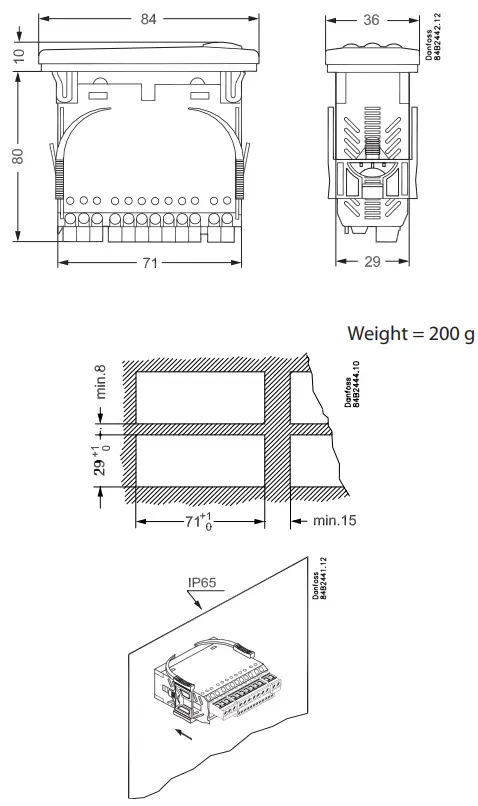
Danfoss can accept no responsibility for possible errors in catalogues, brochures, and other printed material. Danfoss reserves the right to alter its products without notice. This also applies to products already on order provided that such alterations can be made without subsequent changes being necessary in specifications already agreed. All trademarks in this material are property of the respective companies. Danfoss and Danfoss logotype are trademarks of Danfoss A/S. All rights reserved.
Lipotso Tse Botsoang Hangata
How do I start a defrost cycle?
A defrost cycle can be started in various ways, including interval, refrigeration time, contact signal, manual activation, schedule, or network communication.
What can the digital input be used for?
The digital input can be utilized for functions such as door contact with an alarm notification if the door remains open.
Litokomane / Lisebelisoa
 |
Danfoss EKC 202A Taolo ea Taolo ea Mocheso [pdf] Bukana ea Mosebelisi 202A, 202B, 202C, EKC 202A Controller Bakeng sa Taolo ea Mocheso, EKC 202A, Molaoli oa Taolo ea Mocheso, Bakeng sa Taolo ea Mocheso, Taolo ea Mocheso |



